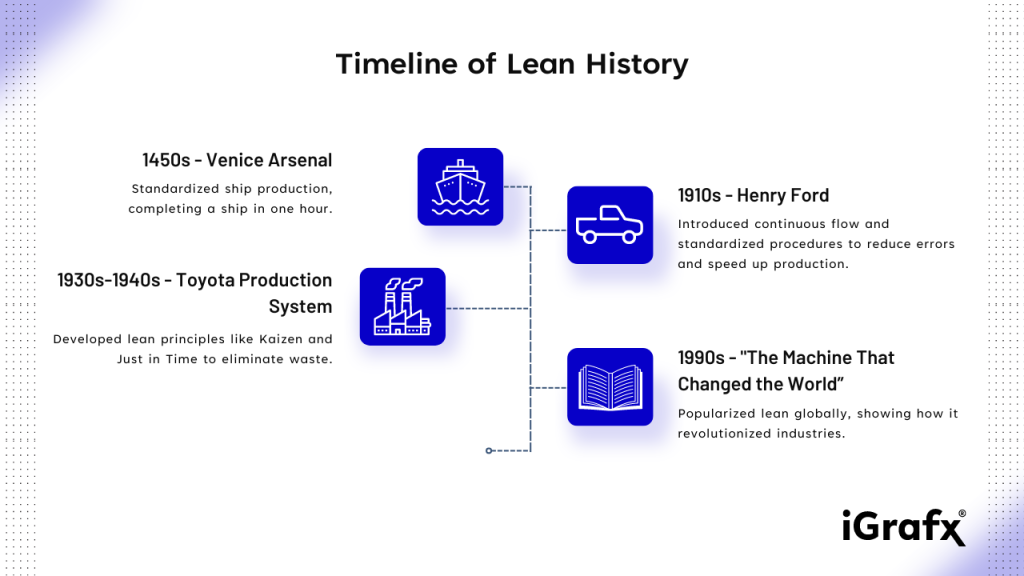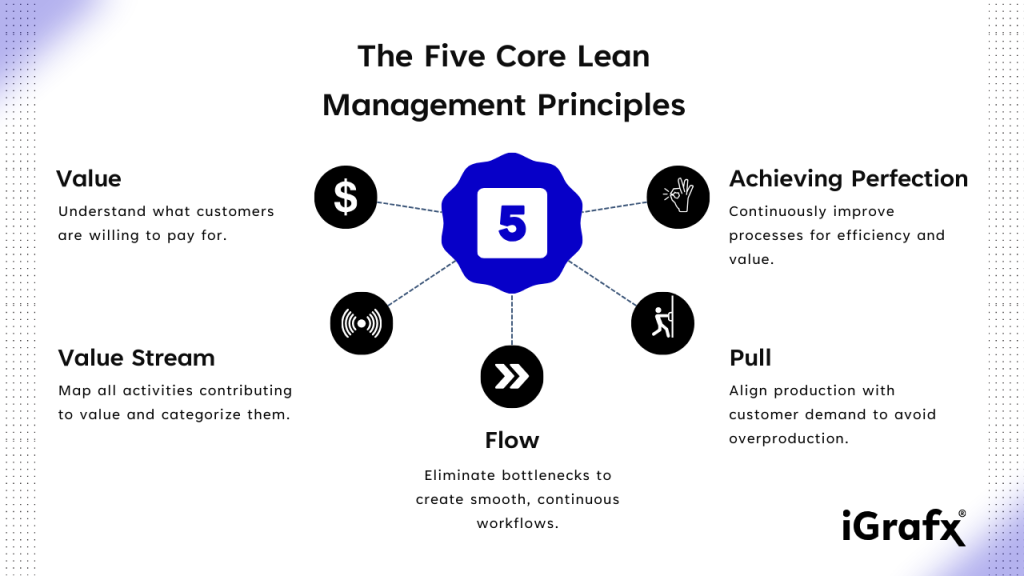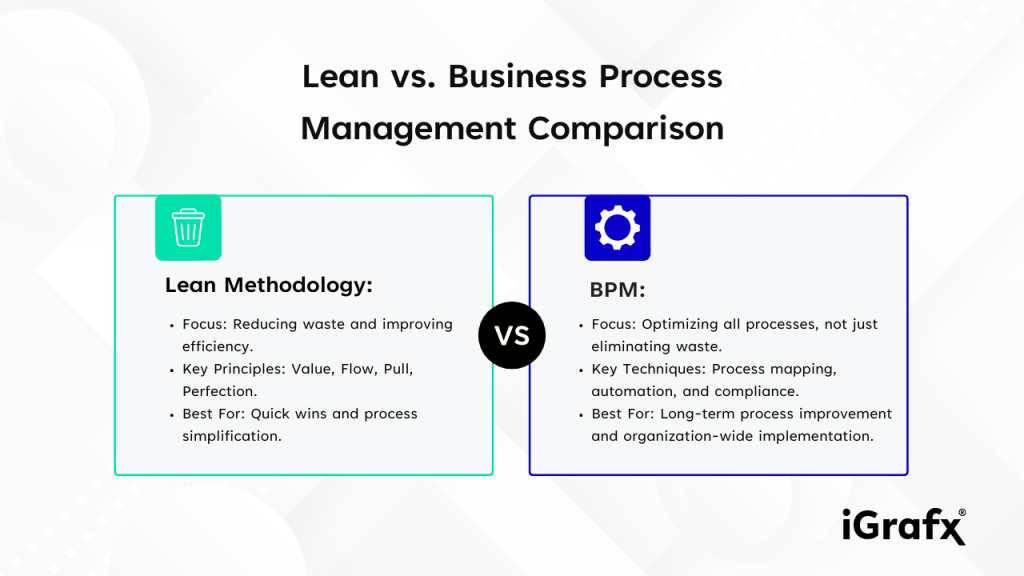Lean methodology is all about continuous improvement, with the main goals of reducing waste, enhancing efficiency, and streamlining business processes.
In simple terms, lean thinking is about looking at a company’s processes and asking yourself the following questions:
- Does each activity add value to the customer?
- Can we complete this activity in less time with fewer resources?
- Can we eliminate the activity?
- How could we improve the workflows?
- What’s holding us back from achieving perfection?
Regardless of your industry, lean management can help you enhance customer experience, optimize wasteful processes, and improve quality.
In this guide, you’ll learn:
- The history of lean methodology
- Five core lean management principles
- Essential tools and techniques
- The advantages and challenges of lean
- How lean methodology and business process management differ
- Why you should leverage both methods for your organization
- Use cases for BPM and lean methodology
A quick history of lean methodology
Lean thinking became popular in the 1990s, but the principles behind the methodology date back hundreds of years. The Venice Arsenal created ships for the navy and implemented processes that standardized and streamlined the production line.
These processes were implemented in the 1450s and enabled workers to move galley ships through the production line in one hour. The innovations were so ground-breaking that King Henry III visited the site to witness the process.
Henry Ford was also an innovator in lean thinking, introducing continuous flow and standardized procedures to reduce errors and speed up production.
The Toyota Production System
Toyota developed the lean methodology we know and love today in Japan. The company faced significant constraints in the 1930s and 1940s, but the Toyota Production System was designed to mitigate waste and speed up production.
The TPS principles, including Poka-yoke, Kaizen, and Just in Time, gained traction thanks to a book written in the 1990s. The Machine That Changed the World brought lean principles to a global audience, resulting in an efficiency renaissance.
Today, lean management isn’t just for the manufacturing industry; healthcare, government authorities, service-based businesses, and more also implement it in their practices.
What are the core lean management concepts?
Lean methodology uses five fundamental concepts that serve as guidelines for organizations that want to enhance efficiency and promote a culture of continuous improvement:
- Value
- Value Stream
- Flow
- Pull
- Achieving perfection
Let’s take a look at each in more detail.
Defining value
Every business needs to identify the value its services or products bring to customers. Understanding their wants and needs is the first step, but you must also establish how much your customers will pay.
Using website analytics, surveys, and interviews can help you better understand your target audience. Remember, consumer wants and needs change constantly, and if you can’t clearly define the value you provide, they’ll go elsewhere.
Mapping your value stream
Once you’ve defined your company’s value, you’ll need to map how processes and activities add to that value and split them into categories:
- Necessary But Non-Added Value: These activities are vital to your processes but don’t contribute to the customer’s perception of value—for example, quality assurance, compliance, and equipment maintenance.
- Unnecessary Non-Added Value: UNVA processes and activities don’t offer value and create excess waste. Examples include ordering excess stock, investing in more resources, and waiting for equipment for a long time.
- Value-Added Activities: These activities transform the service or product, increasing its value in the customer’s eyes. Examples include assembly, manufacturing, and service delivery.
In Lean, value counts as anything that the customer is willing to pay for. While quality assurance is crucial for ensuring customer satisfaction, it’s a necessary but non-added value activity as customers don’t directly pay for it.
But, it maintains product quality and prevents reworks, ultimately contributing to overall value.
To identify unnecessary processes, ask yourself if the activity directly adds to the customer’s perceived value. If not, it may be a candidate for elimination or optimization.
Consider the potential consequences of removing any process, as it could reduce customer satisfaction and negatively impact your company’s reputation.
Flow creation
Flow in Lean is the smooth and uninterrupted movement of work through a process.
Companies achieve this by eliminating bottlenecks, reducing inventory and optimizing workflows, improving overally business performance.
Creating flow is essential after eliminating waste, as it ensures the processes are smooth and don’t cause unnecessary delays. During this stage, your employees come first, as any changes will impact them.
When you create flow, it’s crucial to implement strategies for a smooth transition, including:
- Offering training and skill development
- Setting standards and expectations
- Providing guides and workbooks
- Introducing cross-functioning departments
- Ensuring an even distribution of workloads
Establishing pull
A pull system is a strategy that ensures work only begins when there’s a demand.
This approach eliminates waste by aligning service delivery and production with process based on forecasts or assumptions, pull systems use signals or triggers from downstream activities, then initiate upstream actions.
By focusing on producing only what’s needed, when it’s needed, pull systems can help to reduce inventory levels, improve efficiency, and enhance responsiveness to customer demands.
Achieving perfection
An organization that creates a continuous improvement and growth culture can survive new trends and industry changes while still delivering customer satisfaction.
Evaluating changes within processes and inspiring employees to feel passionate about changes enables your company to grow and scale. Remember, lean practice isn’t a one-time thing; it’s an ongoing practice that requires frequent monitoring.
Vital techniques and tools in lean thinking
So, now that you know the key principles of lean, it’s time to reveal the techniques that make it possible. Each technique contributes to identifying inefficiencies and mitigating them through specialist tools and methods.
5S
The 5S methodology lays the foundations for your lean management system. It has five principles, with each playing a vital role in reducing waste, lowering costs, and enhancing employee morale:
- Sort (Seiri): Removing unnecessary items from the company, such as old equipment and unused materials.
- Set in Order (Seiton): Organizing equipment and materials for easy access and allocating a designated place for essential items in the workplace.
- Shine (Seiso): Retaining a clean work environment by immediately removing debris and dealing with spillages.
- Standardize (Seiketsu): Develop standard procedures for all employees to follow and implement visual tools for management and order.
- Sustain: (Shitsuke): Evaluating whether employees meet standards and offer training.
The 5S process might seem simple, but it requires collaboration and acceptance from all employees.
Kanban
Workflow visualization helps key stakeholders identify the status of different tasks and isolate process bottlenecks. Kanban boards use the pull system, moving tasks to the next stage as and when they’re ready instead of pushing them through.
Each card represents a different task, and the boards have WIP (work in process) limits to improve the flow of processes and prevent overloads.
Kaizen
In Japanese, Kaizen means constant improvement. It encourages all employees to contribute their ideas on how to implement process improvement in the workplace. It’s vital to achieving perfection and can be beneficial for high-level management teams.
All tasks and workflows contribute to organizational-wide goals, but senior managers might overlook individual employee tasks. By inspiring each worker to suggest changes, a company can implement a lean approach across all operations.
Just in Time
No pull strategy can work without leveraging the Just in Time technique. The approach promotes producing and delivering products when needed, reducing the risks of excess inventory. Just in Time is essential in lean production, increasing cash flow and boosting efficiency.
Poka-Yoke
Poka-Yoke (mistake-proofing) is a technique that implements processes and systems to prevent errors.
While quality assurance is often considered a necessary but non-added value activity, poka-yoke is a proactive measure that helps to reduce the need for rework and inspection, enhancing efficiency and quality.
Mistake-proofing is vital in a pull system, ensuring that products and services meet customer expectations.
By preventing errors at the source, poka-yoke can help eliminate defects and reduce waste, resulting in higher customer satisfaction rates and more profitability.
Lean methodology benefits:
- Efficiency: Lean management enhances efficiency, enabling organizations to preserve resources and achieve better business outcomes.
- Quality: As lean methodology relies on minimizing errors and improving quality, it can deliver more value for the customer.
- Fewer Costs: All companies want to improve their bottom line and generate higher profits. Value stream mapping can remove unnecessary expenses, increasing financial performance.
- Engagement: Employee productivity and retention rates are ongoing concerns for businesses, but lean management fosters a culture of collaboration and progress. By empowering workers, companies can reduce high turnovers.
The drawbacks of lean management:
- Long-Term Issues: Lean methodology focuses on immediate improvements to cut costs and increase efficiency. Businesses often forget to consider the long-term implications of each decision, which could cause unsustainable practices.
- Insecurity: Some employees resist change and might feel overwhelmed when their company starts to practice lean techniques.
- Quality Control: Lean management involves balancing costs and quality. A focus on efficiency could lead to quality control issues.
- Investment: If a company plans to transition to lean techniques, it will need to invest in ongoing training and restructuring. Small businesses with limited resources might find it too expensive to practice lean.
Is lean management or business process management better?
When you want to achieve operational excellence and maximize efficiency, there are many things to consider—including whether lean management, Six Sigma, or BPM is the best choice for your objectives. Each methodology has similar goals, but the disciplines and techniques differ.
We already know what lean management is, but how are business process management and Six Sigma different?
- Six Sigma: The Six Sigma methodology eliminates product and service defects. It focuses on customer expectations and aims to deliver products that meet them. Simply put, the methodology revolves around creating superior services and products.
- Business Process Management: BPM is a vital strategy for organizations that want to optimize and improve all processes. It’s a more holistic approach than lean management, which aims to prevent waste and enhance efficiency.
While lean management is best for organizations that want to simplify processes and secure fast wins, BPM software enables companies to refine processes and implement changes that lead to long-term benefits.
You can think of lean process methodology as part of the business process management umbrella.
Leveraging the powers of BPM and lean management
Many believe lean management and business process management directly compete with one another, but combining the two for maximum benefits is possible. Here’s how:
Mapping processes and eliminating bottlenecks
Process mining isolates key business processes and maps them, enabling managers to identify bottlenecks within workflows. Lean management techniques can use these maps to pinpoint excess waste, giving you a complete view of each workflow.
While lean management identifies inventory, overproduction, waiting, and defects, business process management examines the steps within each process and highlights activities that don’t add value.
Optimization and standardization
Lean practices can optimize processes by getting rid of wasteful activities and focusing on the ones that offer value. BPM can help organizations remodel and simulate processes, isolating their performance before officially implementing each process across departments.
Lean techniques will create standardized procedures, but BPM can develop formal procedures and documentation, facilitating compliance and governance.
Promoting a cycle of continuous improvement
Once necessary changes are identified, it’s essential to monitor each new process’s impact. BPM builds an organization-wide framework for the implementation and monitoring of changes. Lean management also promotes continuous improvement through Kaizen.
Use cases for a combined BPM and lean approach
Knowing when to combine BPM and lean methodology can be challenging, but both approaches work better for some industries than others. Next, we’ll reveal the industries where a tactical combination can result in better outcomes.
BPM and lean manufacturing
The manufacturing industry can benefit from leveraging both methodologies for supply chain management. Lean techniques will eliminate waste in production and distribution, while BPM can automate mundane tasks and monitor compliance when working with third-party suppliers.
Healthcare
All healthcare providers know that a patient-centric approach is vital for their survival. Combining BPM and lean practices can streamline the patient journey by reducing waiting times and managing flow processes. BPM also develops standards that maintain compliance and third-party relationships.
Financial services
The financial sector is highly regulated, and providers must comply with the laws while providing customers with a streamlined experience. BPM can automate and standardize loan applications, while lean methodology will implement pull systems to reduce application times.
The bottom line
Lean methodology will continue to play a significant role in helping organizations reduce waste and enhance efficiency. Yes, it can be expensive, but many would agree the benefits far outweigh their initial investment.
If you want to prioritize process improvement and solve bottlenecks, combining BPM and lean principles can achieve short- and long-term company objectives. Our Process360 Live software is an innovative solution for businesses of all sizes.
As an end-to-end platform, it can manage an entire process from identification to standardization. Please feel free to book a free trial today and see how it can revolutionize your organization.




